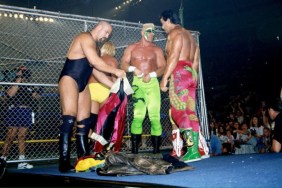It’s not over until the fat lady sings. Everyone has said it at one stage or another; it’s an all-purpose proverb that relates to almost every aspect of life. It is roughly translated to mean that ‘Nothing is truly concluded until the final bell rings’. Nothing exhibits the idea of the ‘fat lady’ any better than pro wrestling. A match can be a brutal one-sided affair for over nine minutes, almost guaranteeing a victory by the dominator, when in an instant the bloodied underdog hits a spectacular finisher out of nowhere to steal the victory. Realism isn’t the top priority of the sport, but entertainment is, and such astonishing triumphs accomplish this perfectly.
Often people criticize and ramble about ‘ring psychology’, defined as an intangible set of guidelines and conventions that develop a storyline or feud amidst an entertaining match. Being such a subjective topic, conflict arises amongst theorists who have their own ideas on what ring psychology actually is, the debate usually ending with both agreeing to disagree. Although ring psychology is clearly a dead horse, there is a feature of wrestling disregarded for being mere fluff. Finishing maneuvers.
As difficult as it is to admit, WWE matches have only a small repertoire of options to end matches with. Disqualifications, clean wins and interferences are the most regularly utilized, with a scattering of sporadic and unique conclusions such as that of the JBL/Big Show cage match at No Way Out. However limited the options are, on the whole, each ending is appropriate to a situation, thus the cyclical nature of finishes is seldom noticed.
In actuality, the way in which a match concludes governs how the fans not only see the match, but also how it affects the feuds concerned. In that sense, the finish of a match is just as important, if not more, than the twenty minutes preceding. For this reason alone, the construction of the finale to a match, has to be constructed intricately and down to the last detail, in order to convey the subtleties the match was intended to convey.
Wrestling is just a modern reflection of glorious ancient gladiatorial battles; the incentive to tune in is the triumph of the blue-collar hero over the seemingly invincible opponent. So, in order to achieve this, the match and its finale must satisfy the audiences’ thirst for glory, or otherwise the audience has been on the edge of their seats for a pointless tussle between two middle-aged men. Without conquest wrestling is pointless.
There’s no coincidence that the golden boys of wrestling, the men who carry the hopes of the audience on their broad shoulders, are also the men with mediocre wrestling skills. Mediocre, in the sense that they aren’t skilled enough to carry a one hour classic, but competent and confident enough to construct a clear and simple match that gets the job done. Wrestling skill doesn’t reach into the chests of fans and tug dramatically at their heartstrings; it’s a combination of intangible elements that causes an emotional effect.
The intangible elements are complex and intricate to dissect as they differ and no one has a solid intellectual grasp of what they are, but there is an aspect that is simple and is featured habitually in matches. The art of the finishing move.
It wouldn’t be thought that a finishing move can hold bearing over how successful a wrestlers career is, but an appropriate finishing move can be the muse to an average wrestler. For a finishing move to be successful there are several features it must have, the primary one being easy recognition and distinction from other moves. The greatest finishers are the coat of arms of a wrestler, whenever any other star dares to use it, it’s still referred to as the other stars maneuver. The Undertaker’s tombstone, Stone Cold’s Stunner, and Bret Hart’s Sharpshooter, are all testament to this. By taking ownership over a maneuver, a star gets his own ‘tag’, a stamp which whenever seen instantly produces images of the star in the audiences head. The advantage of having such a tag is that your matches become your own, it distinguishes the match and its ending from every other bout on the undercard. When a match is different, the fans are entertained, and more importantly, take notice.
The Diamond Cutter and Sweet Chin Music are equally as triumphant moves, yet they take opposite approaches. The Diamond Cutter, The Angle Slam, and the Stunner all have a characteristic which detonates the audience whenever they are severely executed. Unpredictability. Out of nowhere, a sudden flash of movement and Stone Cold’s opponent is on the mat mid-seizure. The sheer shock excites the audience, and increases the longevity of the star. As a star gains notoriety for having an explosive finisher, fans begin to take notice of his matches, before long he has developed an avid cult following. All because each time he steps in the ring, the audience have no idea what will happen next, the unexpected randomness attracts fans.
The Sweet Chin Music on the other hand moves in a completely reverse direction. Matches build tension towards the finale, a gradual crescendo. Fans love tension, it makes them nervous, it makes them sweat, and it makes them tune in next week to see what happens. It’s a very powerful device. So understandably tension can exponentially enhance a finisher. Think Sweet Chin Music, think Pedigree, think Chokeslam, all perfectly use tension to boost the impact of the finisher. Each of these moves engage, and then have a period of time where the fans sit with baited breath preparing themselves for the collision. This is so powerful because, although the fans know what’s coming, they still want it to come, so by pausing momentarily the star teases the audience, dangling the ripe orange carrot in front of the mule.
Finishing maneuvers are never blamed for a good match, yet they are the pivotal climax that concludes every match. Rarely are classic matches remembered for what happened during the match, instead remembered for the spectacular peak of the match. Hogan slamming Andre or Triple H tapping out. The finales of matches mold memories, and the trademark finishing maneuvers are the catalyst for these memories. The intention is that every time John Cena raises a figure of authority onto his shoulders and throws him to the ground in rebellion, he represents the triumph of the blue-collar audience over their suburban monotony. Finishing moves are a lot more than what you think they are.
If you’d like to send me feedback or a question, send it to TheButchershopColumn@hotmail.com. All mail is answered ASAP.
Over and Out
The Butcher








